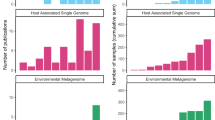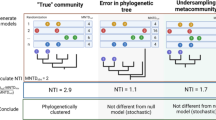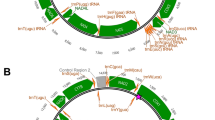Abstract
Second-generation sequencing technologies are fueling a vast increase in the number and scope of metagenome projects. There is a great need for the development of new methods for visualizing the relationships between multiple metagenomic data sets. To address this, a novel approach is presented that combines the use of taxonomic analysis, ecological indices and non-hierarchical clustering to provide a network representation of the relationships between different metagenome data sets. The approach is illustrated using several published data sets of different types, including metagenomes, metatranscriptomes and 16S ribosomal profiles. Application of the approach to the same data summarized at different taxonomical levels gives rise to remarkably similar networks, indicating that the analysis is very robust. Importantly, the networks provide the both visual definition and metric quantification for the non-rooted relationship between samples, combining the desirable characteristics of other tools into one.
Similar content being viewed by others
Log in or create a free account to read this content
Gain free access to this article, as well as selected content from this journal and more on nature.com
or
References
Altschul SF, Gish W, Miller W, Myers EW, Lipman DJ . (1990). Basic local alignment search tool. J Mol Biol 215: 403–410.
Bray JR, Curtis JT . (1957). An ordination of the upland forest communities of southern Wisconsin. Ecol Monogr 27: 325–349.
Bryant D, Moulton V . (2004). Neighbor-net: an agglomerative method for the construction of phylogenetic networks. Mol Biol Evol 21: 255–265.
Gilbert JA, Field D, Huang Y, Edwards R, Li W, Gilna P et al. (2008). Detection of large numbers of novel sequences in the metatranscriptomes of complex marine microbial communities. PLoS One 3: e3042.
Gilbert JA, Field D, Swift P, Newbold L, Oliver A, Smyth T et al. (2009). The seasonal structure of microbial communities in the Western English Channel. Environ Microbiol 11: 3132–3139.
Goodall DW . (1964). A probabilistic similarity index. Nature 203: 1098.
Goodall DW . (1966). A new similarity index based on probability. Biometrics 22: 882–907.
Huson DH, Auch AF, Qi J, Schuster SC . (2007). MEGAN analysis of metagenomic data. Genome Res 17: 377–386.
Lebart L, Morineau A, Félon JP . (1979). Traitement des Donndées Statistiques - Méthodes et Programmes. Dunod: Paris.
Legendre P, Legendre L . (1998). Numerical Ecology. English edn. 20: i–xv, 1-853.
Odum EP . (1950). Bird populations of the highlands (North Carolina) plateau in relation to plant succession and avian invasion. Ecology 31: 587–605.
Rao CR . (1995). A review of canonical coordinates and an alternative to correspondence analysis using Hellinger distance. Qüestiió (Quaderns d'Estadística i lnvestigació operativa) 19: 23–63.
Rusch DB, Halpern AL, Sutton G, Heidelberg KB, Williamson S, Yooseph S et al. (2007). The sorcerer II global ocean sampling expedition: Northwest Atlantic through Eastern Tropical Pacific. PLoS Biol 5: 398–431.
Seshadri R, Kravitz SA, Smarr L, Gilna P, Frazier M . (2007). CAMERA: a community resource for metagenomics. PLoS Biol 5: 394–397.
Sogin ML, Morrison HG, Huber JA, Mark Welch D, Huse SM, Neal PR et al. (2006). Microbial diversity in the deep sea and the underexplored ‘rare biosphere’. Proc Natl Acad Sci USA 103: 12115–12120.
Venter JC, Remington K, Heidelberg JF, Halpern AL, Rusch D, Eisen JA et al. (2004). Environmental genome shotgun sequencing of the Sargasso Sea. Science 304: 66–74.
Wheeler DL, Barrett T, Benson DA, Bryant SH, Canese K, Chetvernin V et al. (2008). Database resources of the national center for biotechnology information. Nucleic Acids Res 36: D13–D21.
Acknowledgements
We thank Dr Kay Nieselt for helpful discussions and Wei Wu for his assistance.
Author information
Authors and Affiliations
Corresponding author
Additional information
Supplementary Information accompanies the paper on The ISME Journal website
Supplementary information
Rights and permissions
About this article
Cite this article
Mitra, S., Gilbert, J., Field, D. et al. Comparison of multiple metagenomes using phylogenetic networks based on ecological indices. ISME J 4, 1236–1242 (2010). https://doi.org/10.1038/ismej.2010.51
Received:
Revised:
Accepted:
Published:
Issue date:
DOI: https://doi.org/10.1038/ismej.2010.51
Keywords
This article is cited by
-
Soil as an extended composite phenotype of the microbial metagenome
Scientific Reports (2020)
-
Succession and persistence of microbial communities and antimicrobial resistance genes associated with International Space Station environmental surfaces
Microbiome (2018)
-
DectICO: an alignment-free supervised metagenomic classification method based on feature extraction and dynamic selection
BMC Bioinformatics (2015)
-
A DNA-based diagnostic for differentiating among New Zealand endemic Podocarpus
Tree Genetics & Genomes (2015)
-
Predicted Relative Metabolomic Turnover (PRMT): determining metabolic turnover from a coastal marine metagenomic dataset
Microbial Informatics and Experimentation (2011)



